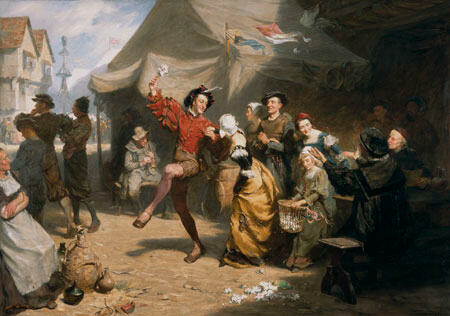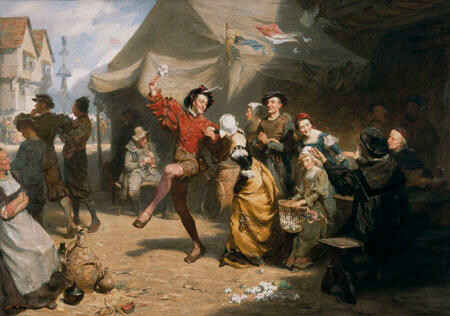Fred Roe
British, b.1864, d.1947
May Day
- Oil on canvas
- Presented by the Canterbury Society of Arts, 1932
- 1275 x 1780mm
- 69/360
Tags: barrels (containers), baskets (containers), benches (furniture), buildings (structures), celebrations, dancers, dresses (garments), festivals, flags, flowers (plants), hats, houses, landscapes (representations), musical instruments, outdoor furniture, people (agents), performing artists, tables (support furniture), tents (portable buildings), urban landscapes
Traditionally, May Day celebrations were about the renewal of life and the beginning of spring. A maypole was erected in the village square and, to the music of pipes, the prettiest girl was led dancing through the village towards her coronation as ‘Queen of the May’. Academic in style, Frederic Roe has captured such a scene with careful paint applications. The brighter, lighter colours of the costumes of the male dancer and the Queen of the May are framed by darker shadowed areas, keeping the main focus on the central characters. Born in Cambridgeshire, Roe was the son of a painter of miniatures. He studied art in London and began exhibiting at the Royal Academy in 1887. He soon developed a successful career as a painter of historical outdoor genre subjects. Roe also painted portraits in oils and watercolour, but his reputation was based on genre pieces. He also had a passion for old oak furniture and wrote and illustrated two popular books on the subject.
In early times the first day of May was known as 'May Day' and celebrated as the renewal of life and the beginning of spring. That tradition is recorded in this historical genre painting of a medieval English village. The flowers and hawthorn blossoms have been gathered, the maypole erected in the village square and, to the music of the pipes, the fairest maid is led towards her coronation as 'Queen of May'. Roe's careful historicism is supported by his precise academic style. Unlike the Pre-Raphaelites who sought the sharper clarity of colour and form of the medieval painters, Roe in this romantic Victorian work, uses a pervasive brown tone and keeps his colour palette within a carefully controlled range.

